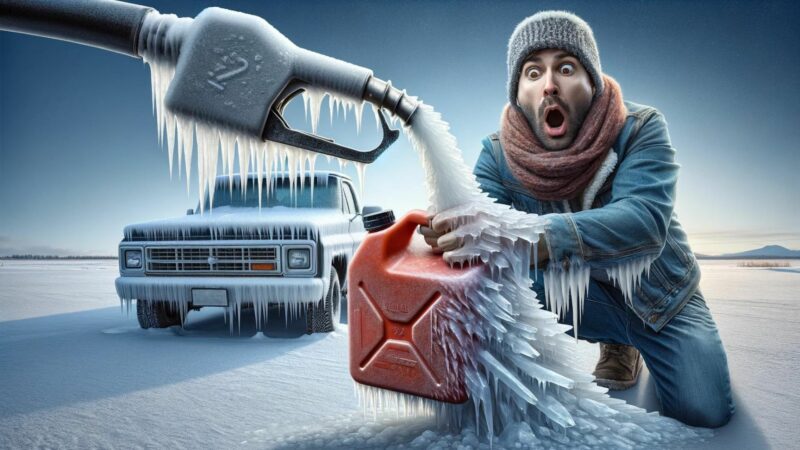Table of Contents Show
Ready or not, frigid temperatures are inevitable for most of the country when Old Man Winter rolls into town. These dreadful conditions can cause issues for vehicle owners, but can they freeze the gasoline in your car?
If you and your vehicle want to survive winter, you must take action before it’s too late. Failing to do so could have devastating consequences.
Today, we’ll see if you should worry about the gasoline freezing in your car and share tips to keep your vehicle safe this winter.
Let’s get started!
What Temperatures Does Gasoline Freeze?
The freezing point for gasoline is somewhere between -40 and -200° Fahrenheit. However, it’s essential to know that this is a rough estimate because it changes based on the blend and additives in the fuel.
Manufacturers who deliver gasoline to colder climates switch to seasonal mixtures, which are more resistant to freezing. This can help avoid potential issues arising from gasoline interacting with cold weather.
Can Gasoline in a Car Freeze?
Yes, gasoline can freeze in a car. While it’s not likely, if temperatures drop below -40° Fahrenheit, it becomes a possibility.
However, it’s more likely to become a slush-like consistency than freeze. It would have to get closer to -200° Fahrenheit to turn into a solid.
We do want to note that the coldest temperature ever recorded on Earth was -128.6° Fahrenheit. This phenomenon occurred at Vostok, Antarctica, on July 21, 1983. If you’re looking for travel destinations, we recommend skipping Vostok.
What Happens If Your Gasoline Freezes?
While it may be unlikely, the transformation from a liquid to a solid state can cause problems for a vehicle.
As we mentioned, gasoline is more likely to turn into a slush-like consistency long before it turns into a solid. This thicker mixture can clog fuel lines and filters.
When this occurs, it restricts the flow of fuel to the engine. An engine needing more fuel will likely experience reduced performance and stalling. These blockages could also prevent the vehicle from starting altogether.
Other issues can arise from gasoline becoming more viscous and the pressure build-up in the fuel system. It can damage fuel lines, injectors, and other components. We don’t know about you, but we’d hate to be on the receiving end of the repair bill in these situations.
How to Keep Car Gas Safe During Cold Weather
If you want to avoid potential issues resulting from freezing temperatures and gasoline, there are some things you can do. Let’s look at some basic steps to protect your vehicle from Old Man Winter.
Add Fuel Stabilizer
One of the easiest things you can do to protect your gas from cold weather is to use a fuel stabilizer. These products can increase gasoline’s resistance to cold weather. You can find them readily available at many big-box retailers and automotive stores.
Follow the manufacturer’s instructions, which typically require adding it with an almost full tank. Let your vehicle run for several minutes to help stir up the mixture and get it throughout the entire fuel system.
We mentioned earlier that some regions of the country that experience extreme winters change to seasonal blends. Some fuel manufacturers will include stabilizers in their seasonal blends to help avoid potential issues during storage and transport.
- Preserves Fuel – Keeps fuel fresh for up to 24 months so you can store the car you’re not driving, keep outdoor power equipment fresh through the winter, or stock up on gasoline without worry
- Prevents Corrosion – Maintains a healthy fuel system by ensuring that your engine and fuel components don’t suffer from the breakdown of ethanol or non-ethanol blended fuels
Keep the Gas Tank Full
Keeping a full gas tank helps reduce the risk of condensation inside the fuel tank. This is more likely to occur when there’s space inside the tank and temperatures fluctuate. Moisture in the air can build up and eventually freeze. These chunks of ice can block fuel lines and create issues.
You can drastically reduce the risk of issues by keeping your gas tank full and using fuel stabilizer products. Eliminating the potential for moisture to accumulate anywhere in your fuel system is the primary goal.
It may not be necessary to stop at the gas station every time you drive your vehicle. However, it’s not a good idea to let your tank get below half full. You want to limit as much as possible the space for air molecules to gather and create problems.
Park in a Garage
If you have a garage, make sure you use it. These spaces provide a controlled environment and an added layer of protection for your vehicle. It not only keeps the winter elements away from your car but also the moisture that often comes with them. For many, pulling their vehicle into a garage is one of the most effective measures.
Parking inside a garage not only helps protect your fuel but also various other components. Keeping your tires and battery as warm as possible can protect them, too.
It’s not uncommon for drivers to experience low tire pressure lights and dead batteries after the first freeze. While a shot or two of air can help tires, the cold can put an aging battery out of its misery.
For those of you looking for an excuse to clean out or organize your garage, now you have one. You may want to make this your next weekend project to help give your vehicle and its gas tank a safe place to park during winter.
Use an Engine Block Heater
Another great solution to protect your vehicle during cold weather is an engine block heater. These devices help maintain the temperature of the engine and fuel system. It warms the engine and keeps your fuel system at a better temperature to help ensure you’re able to start your vehicle.
An engine block heater typically plugs into a standard electrical outlet. You’ll want to give it a few hours to do its job before you plan to start your vehicle. It’ll improve conditions for your car to start, which reduces wear and tear on the components.
An engine block heater is likely only necessary in areas that experience extreme weather.
If you live somewhere that frequently encounters sub-zero temperatures, it might be a wise investment. However, if not, you’ll want to consider other options we’ve shared.

Drive Regularly
Like Newton taught us long ago, objects in motion tend to stay in motion. The same is true of vehicles during extreme winter weather conditions. Driving your car regularly can help avoid stagnant fuel, which results in varnish and gum deposits. These can clog up your fuel filters and create performance issues for your vehicle.
You don’t have to take it out for an extended road trip. A short 20-minute spin around the block is typically more than enough. You want to give it time to warm up and for all moving parts to lubricate properly.
Should You Worry About Your Gas Tank Freezing?
Unless you live in Antarctica, you don’t typically have to worry about your gas tank freezing solid. However, just because it doesn’t turn into a block of ice doesn’t mean you shouldn’t still take precautions.
You should do all you can to avoid it turning to slush, which can also cause problems. By taking the steps we’ve shared today, you can keep your vehicle safe from winter.
Last update on 2024-07-25 / Affiliate links / Images from Amazon Product Advertising API







